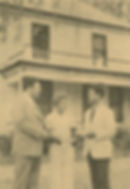Early African American Education in Columbus and William H. Spencer
- Historic Columbus
- Feb 11, 2021
- 5 min read
These history excerpts are from a variety of sources, including: Red Clay, White Water, and Blues by Virginia E. Causey, A History of Education in Muscogee County and the City of Columbus, Georgia 1828 - 1976 by Katherine H. Mahan and William C. Woodall, and the Spencer House National Register Nomination.
In June 1872, Mayor McIlhenny officially advised the Board of Trustees of the Columbus Public Schools that the City Council had passed a resolution instructing the Trustees to establish two new schools for Black children. The Public School’s committee rented Temperance Hall and opened the first school for Black students in July. Temperance Hall, built in 1849 and located in the 1200 block of First Avenue (pictured from a map on the left), had been a center for music and dramatic performances with Blind Tom and John Wilkes Booth having both appeared there. By 1880, the School Trustees acquired Claflin School (pictured in the middle), which had been established by the Freedman’s Bureau in 1868. They also bought a church building on Sixth Avenue (later called the Fifth Avenue School and the Lowe School - and on the right), remodeled and enlarged it for school purposes. In the latter part of the century, they provided other facilities for the growing Black school population. Closing exercises of the Black schools were held at St. James AME. The basement of the church was also used by these schools and five teachers were stationed there. School enrollment in 1882 was: 540 white; 640 Black; 1,180 total.

William Henry Spencer was born in Columbus in 1857. He attended Claflin School, where as a student he taught a class. He married Martha Love and started his career as a teacher in Harris County. William would move his bride to teach in Girard (now Phenix City), before he became a teacher in Columbus in 1875. Mr. Spencer would soon become principal of the Claflin School and the Lowe School (the Sixth Avenue School). He would serve as assistant principal of all Black schools in 1883 and then principal (or superintendent) of all Black Schools by 1885 for many years. He would also retain his position as principal of the Lowe School (pictured below).
In May 1882, 160 Black citizens successfully petitioned the School Trustees asking that the grades of their schools be raised a year, giving a total of nine grades. When he became principal of all Black schools, it was noted in Mahan's book that one of his first requests of the School Trustees was for athletic equipment and facilities. He was denied.

By the 1890s, high schools became a priority for both whites and blacks. The Trustees would continue to deny requests for a Black high school, even with funding coming from the Black citizens themselves. Middle-class Black parents sent their children to high school departments at universities in Tuskegee, Alabama, and Albany, Ft. Valley, and Atlanta, Georgia.

The idea for a high school for African American students wouldn’t gain traction until 1927 – two years after the death of William H. Spencer – when a group of Black ministers appealed to the School Trustees. Even then, it took two more years for the Trustees to consider the idea of adding two more grades before convincing voters to fund a Black high school. It would be named after Spencer with George Foster Peabody, the Rosenwald Fund, and Gunby Jordan contributing toward the school’s construction. Spencer High School was originally built on 10th Avenue and 8th Street in 1930 and designed by local architects, E. Oren Smith and James J.W. Biggers, Sr. In line with the benefactor’s philosophy, Spencer High School stressed vocational education, but many students went on to college. Of the 37 young men and women who graduated in 1934, 16 earned undergraduate degrees and eight did post graduate work, not only at local colleges but also Harvard, NYU, Kent State, and the University of Pittsburgh. Below, the 1934 Spencer football team is pictured.

The construction of William and Martha's home started in June of 1912. The Spencers and their five children moved to their new home in the fall of that same year. The home is located on the SW corner of 8th Street and Veterans Parkway (then Fourth Avenue). It is a good example of an early 20th century Classical Revival architecture and American Foursquare house type. The exterior classical elements include the Corinthian columns and dentil molding on the front porch. Inside, the millwork, especially the mantel pieces, showcases the classical style. William and Martha were blessed with four girls - Pearl, Ann, Ethel, and Alma - and one son, William, Jr. Below are a few family photos - including images of the Spencers when they were married, William Spencer, Jr., Ethel Spencer, and Martha Spencer with Pearl, Ann, and Alma.

The home was given to the Muscogee County School District in the late 1970s by William Spencer’s remaining two daughters, Ethel and Pearl. The Golden Owlettes, a Spencer High Alumni Association, purchased the home in 1978. Along with the Golden Owlettes, Charlotte Frazier, an ardent preservationist, and Representative Calvin Smyre championed this house for many years. Charlotte is pictured in the middle and Calvin is pictured on the right.

Historic Columbus has also been a partner in the preservation of the house since the 1970s. HCF Executive Director Janice Biggers worked alongside Charlotte, Calvin, and the Golden Owlettes for many years to ensure the revitalization of this important structure and to ensure its listing on the National Register of Historic Places in 1978. Historic Columbus has also been fortunate to have assisted in its rehabilitation through the years through two Virginia T. Peebles Preservation Grants.


William Henry Spencer was an important figure in the history of public education in Columbus as an advocate for equal education. Historic Columbus is grateful to the Golden Owlettes, the Spencer High School Alumni, and Representative Smyre for their tireless efforts to preserve his home and his legacy. Next Week: E.E. Farley
SHARE YOUR STORY: Historic Columbus is celebrating Black History Month by sharing some of our community's history through the stories of individuals, places, and events in our town. There is so much history that needs to be shared, and what you will see this coming month is just the beginning. More stories will continue to be shared each week throughout the year. Our community and our people have incredible stories, and Historic Columbus certainly doesn't know everything. We hope you will help us learn the rest of the story...your story, your family's story. Please consider sharing these stories with HCF to help create an oral history collection. You can email hcfinc@historiccolumbus.com. And don't worry, we will keep asking for your stories each month!
You can access ALL of Historic Columbus' History and Preservation Spotlights here: www.historiccolumbus.com/blog AND Tuesdays With Justin here: Historic Columbus (GA) - YouTube












